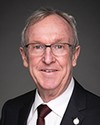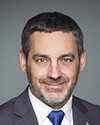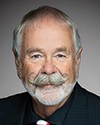[Witness speaks in indigenous language]
Thank you, Madam Chair, and thank you also to the committee.
[Witness speaks in indigenous language]
I am very honoured to be here on unceded Algonquin territory to speak about the very important bill that we're discussing today.
Aanischaaukamikw is the cultural centre for the 10 Cree communities of the Eeyou Istchee in northern Quebec. We run a 30,150-square-foot building that has 3,000 square feet of long-term and temporary exhibition space, visible storage, a documentation and resource centre, state-of-the-art collection storage, including archaeology, and workspace for approximately 40 staff.
Aboriginal cultural property is defined in the bill as “objects”. In our experience, and considering our long-term needs for repatriation, the definition should include intangible heritage, archival documentary materials and all forms of research data. As we struggle to maintain our language, ensure transmission of our culture and traditional knowledge from generation to generation and protect our cultural heritage for generations to come, we understand the importance of ensuring our ability to repatriate materials and objects such as our ceremonial items held in museums in the south and the voices of our elders, long since passed, in university archival collections of anthropologists.
This necessitates inclusion of any research data and documentary materials that are part of indigenous heritage. Much of our cultural heritage is held by museums and academic institutions beyond Eeyou Istchee throughout Canada, the U.S. and in other places in the world.
When we define cultural property, we define it in terms of heritage and identity. Heritage is inextricably linked to identity; therefore, there is no way to separate indigenous cultural property from indigenous heritage as a right.
The bill comes at a time when we're welcoming the ratification of the United Nations Declaration on the Rights of Indigenous Peoples for its assertion that indigenous peoples have the right to practice and revitalize cultural traditions and customs, including the right to maintain, protect and develop the past, present and future manifestations of their cultures, referring to both material and intangible cultural property.
After centuries of colonization and colonial actions that have endangered our ability to authentically enact heritage as a right, we welcome actions such as Bill C-391 if the enactment is an authentic way of supporting our right to heritage and ensuring that our cultural property is protected and preserved for generations to come.
Although the scope of Bill C-391 places aboriginal cultural property wherever it is situated, in order for this to be comprehensive and meet our needs, this must be clearly understood to include holdings in other countries beyond Canada. We have items of great significance to our heritage throughout the United States and Europe as well as in many places across Canada, and much of this consists of sacred and ceremonial items.
The lack of strength in statements as a result of utilizing phrasing such as “encouraging” the return of property rather than “requiring” the return of cultural property is of concern in the light of calls for authentic implementation of the UN declaration and the TRC calls to action. The two documents, if taken seriously, require a complete reframing and revisioning of the relationship between indigenous nations, their cultural institutes and mainstream museums.
The bill refers to “owners, custodians or trustees”, which are typically self-appointed positions when it comes to indigenous heritage or intangible cultural property. This is a subtlety in power dynamics that should be more widely understood within the discourse surrounding repatriation as an act of reconciliation.
It's also worth noting that the owners, custodians or trustees referred to in this section have profited from the property they hold, using it to raise profile, develop programming, legitimize their standing as institutions and raise capital. From this view, it should be recognized that the owners, custodians or trustees are indebted to the source communities. The mainstream heritage community and the indigenous heritage community together need to collectively advocate to reframe the relationship as a matter of reconciliation. In fact, the ways in which indigenous cultural property is discussed and publicly labelled as “collections” or “artifacts” work to whitewash processes that are quite violent in nature.
In terms of our territory, items from our territory ended up in museums, academic collections or private collections through means that were more than dubious in nature. Yes, some were bought and paid for, but even when this happened, the collector was frequently in an advantaged position of wealth and power, not facing starvation or other catastrophic life events.
Take, for example, the case of ceremonial objects that we know are in museums across the country and around the world and that we know originated in our communities.
One such ceremonial item, a woman's beaded hood from the mid-1800s, used to honour our relationship with the animals that we depend on and to celebrate life events, was found in a museum in Montreal. Through our research, we tied this ceremonial hood to one of our communities in northern Quebec. We knew which family it was from and we knew who the hood-bearer was in the 1800s, but we were unable to determine how the hood ended up in the hands of a collector, and from there in a mainstream urban museum. We can only theorize that if the hood were not obtained through theft or forcibly taken, then the family would have been in such a state of extreme hardship that they would have needed to part with this important family inheritance, an important tie to their spiritual and ceremonial life.
If we are able to only discuss and acknowledge the fact that the removal of parts of our cultural heritage from our communities was facilitated by undesirable economic or social conditions, or that they were stolen or taken by force, or even unexplainably ended up in the hands of a collector, we have not arrived at the point as a society where we can merely “encourage” the return of indigenous cultural property. In keeping with this, support for the process referred to must ensure that indigenous heritage organizations and communities are not burdened with any costs related to the process of re-homing cultural property.
From our experience, transporting an object from a museum in Montreal or Toronto can cost tens of thousands of dollars. For a small non-profit institute, this is a burden that is taken on with the knowledge that our ability to provide access to parts of our tangible heritage that have fallen out of memory or use within our communities is an important aspect of cultural revival and maintenance of heritage. If we're speaking, as referred to in clause 3, of support for preservation and access, this should be understood to mean the financial support necessary to do this work properly. In addition, this support should ensure that the cost is not borne by indigenous communities or organizations. Authentic financial support takes into account transportation costs, conservation costs, and facility and operations support. There are other considerations that must be taken into account here, including support for increasing capacity within indigenous nations, human resource training, and facilities development.
Our facility, Aanischaaukamikw Cree Cultural Institute, located in Oujé-Bougoumou in northern Quebec, serves our entire nation of 10 Cree communities across Eeyou Istchee. We own and operate a state-of-the-art facility that has achieved category A designation from Canadian Heritage, a designation that recognizes our facility is on a par in terms of conservation and storage facilities and capacity with many of the major museums in this country.
More and more across the country, indigenous organizations are developing these types of institutes and supporting their ability in cultural heritage management. The bill calls for support for repatriation of cultural property, which must include support for the development of the facilities necessary to house such property.
Further, regarding access, it would be preferable if there would be no room for conditional demands on indigenous communities centred in western museological norms that restrict access for any reason that an indigenous community deems valid. Control and access decisions should remain in the hands of indigenous communities or their representative organizations, and that authority must be well recognized.
Frequently we're met with resistance from museums to access because of their reliance on decision-making protocols that are based in western museological norms. These norms don't take into account our own knowledge about how ceremonial items and other items should be cared for and handled. In many instances we found that our objects are improperly cared for and disrespected in mainstream museums because of their reliance on western museological norms. In many cases as well, proper care of the object would entail its relocation to the territory it originated in and to which its spiritual life is tied.
The dislocation and disrespectful handling, even incidentally, of our most precious heritage objects is a pain that this bill could work to alleviate. It should also be noted that in many cases collective items have been subjected to less than ideal storage situations. Many sacred and ceremonial and otherwise important objects have been sprayed with pesticides and neglected as low-priority items in museums, as we have found in some of our cultural property that's held overseas.
The need for support in repatriation of indigenous heritage property is contextualized for us by the fact that much of the collecting work took place during an era of empire expansion, when indigenous cultural items were viewed as exotica, fetish and salvage. In light of these points, there's much repatriation work to be done.
In regard to claims on collections extracted from indigenous communities and territories, especially following contact with Europeans, there was rarely any form of proof of ownership in the sense of documentary evidence. The burden of proof can't be borne by indigenous communities alone. While research must be done, this must be led by indigenous communities but supported financially and otherwise, without placing costs on indigenous communities. In addition, oral tradition and oral discourse need to be valued in terms of this research that's done to place objects within their home communities.
I'd like to take a moment to recognize the work of Mr. Casey and others who developed this bill and also acknowledge that, if passed, it would be a substantial support to our efforts to ensure cultural maintenance and access to our own heritage. Repatriation of cultural property allows us to ensure access to heritage to the population we serve. It creates deep and meaningful experiences and learning opportunities that allow us to reclaim aspects of ourselves and who we are, learning about ourselves as we bring our cultural property home.
Thank you, Madam Chair.





